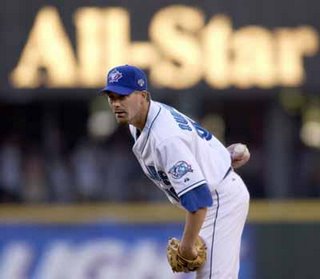Captain Quantrill
Time is passing us by. Back in December I paid tribute to the freshly-retired John Olerud, one of the game’s most reliable producers in the 1990s, and the holder of the second-best career fielding percentage of any player in major league history.
What Olerud was to the batting order – a significant but under-recognized contributor to his team’s success – Paul Quantrill was to the bullpen.

Quantrill announced his retirement on the weekend, although fans will get to see him pitch when he takes the mound for Canada at the WBC tournament. (Let’s hope his next outing goes better than the fifth inning did against South Africa.)
The player we’re seeing at the WBC is a diminished version of one of baseball’s best middle relievers. From 1997 to 2002 – seven straight seasons – Quantrill dominated the American League, throwing 537 innings with an average ERA+ of 171.
From 2001 – 2004 he typically pitched in more than half of his club’s games, making at least 80 appearances each season, and topping-out at a whopping 89. His four straight seasons of 80 appearances was a first in the majors, and his 609 appearances over eight years (1997-2004) was the second highest total ever recorded over an equivalent span (Kent Tekulve holds the record).
Day after day Quantrill would emerge from the bullpen, his arm remaining fresh even as the season wore on. In 2003, his last dominant season, his ERA stayed under 2.00 every month of the year, and his full-year ERA was the best ever recorded by a pitcher making more than 80 appearances.
His career ERA+ of 119 ranked 20th among active players at the end of the 2005 season, at the same level as household-names like Glavine, Lowe, Petitte, Colon and Mulder.
Was Quantrill ever a household name? Unfortunately, no. The closest he came was being named to the 2001 All-Star team, thanks in part to opening the season with 23 straight scoreless innings, and equally thanks to the lack of conventional candidates from Toronto’s rotation. That year, finally, he was the middle reliever no one could ignore.
If there remains hope for long-term recognition of the role, it must come from the performance of men like Paul Quantrill, who defined excellence at the position.
One day, perhaps, elite middle relievers will be appreciated for their contributions, and even considered by Hall of Fame voters. The Hold has not captured the imagination like the Save, but the Save itself took decades to become established as a Hall-worthy metric.
AFTERTHOUGHT: As Baseball Crank demonstrated with his retrospective analysis, teams ignore middle relievers at their peril. A team’s top two relievers pitch on average about 10% of a team’s innings each year, compared to about 50% of innings by the top-four starters, and 40% of innings from the rest of the bullpen and other starters.
Based on this, and examples like Paul Quantrill (who never cost the Blue Jays more than $1.8 million), thoughtful upgrades to the non-marquee staff look to me like a superior use of an owner’s marginal dollars.



0 Comments:
Post a Comment
<< Home